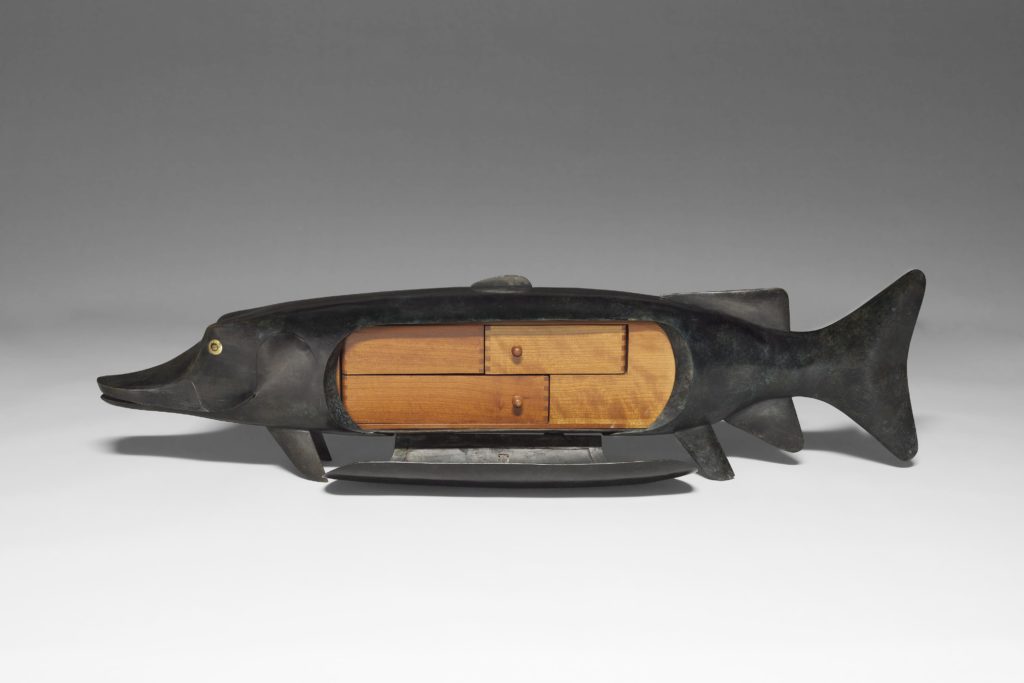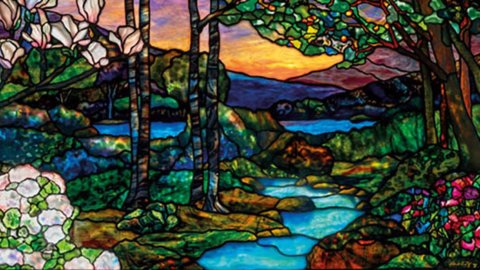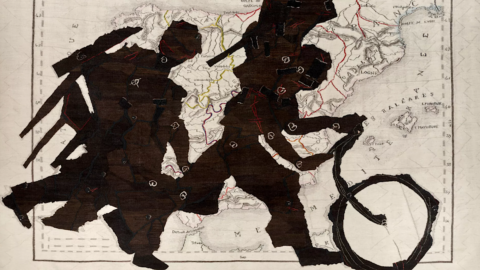Previews are available in Christie's galleries in New York starting May 22, by appointment only. To book an appointment, click here.
TIFFANY | MAY 26th
Christie's is pleased to present Tiffany, a live sale in New York dedicated to the works of the American visionary Louis Comfort Tiffany. The sale is led by a magnificent "Landscape Window with Magnolia, Hydrangea and Azalea", circa 1915, which ranks among the most spectacular and artistic of the windows created by Tiffany Studios in the early XNUMXth century. Kept for over forty years in a private collection, this landscape is meant to be a representation of the Kissena brook and its surrounding woodlands and shows an exceptional selection of the most elaborate glass used at the time.
From the impressionistic, almost abstract foliage to the naturalistic trompe-l'oeil trees and river rocks reflected in the stream, this window is among the most spectacular and artistic of the windows created by Tiffany Studios in the early XNUMXth century. During that most fertile period, Tiffany and her stained glass studios executed commissions of extraordinary beauty and technical complexity. The depth and realism of the composition is achieved by a masterful layering of the most elaborate glass available to Tiffany Studios at the time. In the foreground, delicate branches support pink and white magnolia blossoms fabricated with a softly undulating glass drapery. Below them, a cluster of hydrangeas is in bloom, their mottled white glass accented with multicolored fractured scales and surrounded by dark green variegated glass. On the opposite side of the window, red and yellow mottled glass fruits are scattered in a poetic arrangement on arching branches. In the distance, a lake rendered in multiple layers of shimmering "flashing" glass reflects the setting sun. A spectacular range of Tiffany's innovative Favrile opalescent glass is used throughout: mottled and fractured glass; Multi-dimensional drapery glass and rippled and granite-surfaced glass, as well as several plated layers consisting of various textures, shades and colors, demonstrate the highest level of artistry.
Called “the Kissena Window” by the family of the previous owner, this landscape is thought to be a representation of Kissena Brook and its surrounding woodlands and is believed to have been commissioned by American landscape architect Samuel Bowne Parsons, Jr. The family Parsons Nursery in Kissena, Flushing was founded by his father in 1838. The first pink flowering dogwoods were introduced there, plus they were the only growers of hardy rhododendrons and azaleas in New York at the time.
Agnes Fairchild Northrop, one of Tiffany Studios' foremost designers, was born in Flushing in 1857 and spent much of her time in Kissena nurseries. Known for her “natural talent for floral designs” (Art Interchange, 1894), she joined Tiffany's studio in 1884 and eventually became responsible for the design of many of her most important window commissions. Northrop worked at the Studios until it closed in the late 30s. Tiffany has granted her privileged status, including her own separate private studio. In her memoirs, Northrop describes her position in her studies: "I managed to make a place for myself between the flowers and the landscape (I didn't do Figures)." At the time, the Tiffany Glass furnaces in Corona were located a short distance from the city of Flushing and Parson's Nursery. Because of the importance of the nursery, this area was considered a horticultural center and "the nursery capital of New York" (Alice Cooney Frelinghuysen, Glass Gardens, Agnes Northrop's designs for Louis C. Tiffany, lecture at the Smithsonian American Museum, Washington, September 2016). Like Tiffany, Northrop was fascinated by all aspects of nature, documenting her favorite flowers through her photographs and drawings and using them for inspiration. Lot 128, a selection of reference photographs from her own collection, includes several images of magnolias and hydrangeas, some of which she penciled “Kissena nurseries, Flushing”. Northrop was an avid flower painter, she would sketch in watercolors from nature to creatively capture the subtle color gradations of the petals and leaves that would appear in her windows. Among Northrop's most notable projects would be the DeForest Autumn window in the collections of the Metropolitan Museum of Art, New Yok. "The appearance of a landscape is constantly changing", said Monet in 1891, "it lives by virtue of its surroundings - the air and the light - which are constantly changing".
The luminosity of Favrile glass and the virtuosity of its selection make this window a constantly evolving landscape. The light animates an allegorical vision of Kissena, making it an endless exploration of the wonders of nature and a “candy for the eyes”. As the painter and critic Roger Riordan states in "American Stained Glass", American Arts Review, 1881, Tiffany's work "speaks, as nature does, through the eye to the mind and feelings."
A lush and beautiful landscape of a babbling brook with a lake beyond, it is the composition and glass selection of this window that set it apart from other Tiffany landscapes. Depicting spring and the first growing season in the wood, the four corners of the window celebrate individual blooms: magnolias, hydrangeas, azaleas with the upper right quadrant dominated by a fruit tree. An exceptional selection of Favrile glass includes white glass with pink highlighted drapes for the magnolia blossoms and some of the brightest mottled glass for the hydrangeas. Intersparse among the flowers are dark green confetti leaves. The azaleas are represented by brilliant fuchsia glazes set between confetti glass leaves, the overhanging branches with their carefully selected yellow and orange glazed fruits. An exceptionally realistic cluster of white birch trees stands in the center of the window. The green, blue, and teal mottled glass tones encompass the undergrowth. The dramatic sky is highlighted in cobalt over deep gold which shades an orange sunset reflected in the distant lake.
The window is thought to represent Kissena Brook in Flushing, Queens, with Kissena Lake beyond, and is believed to have been commissioned by Tiffany Studios from landscape architect Samuel Bowne Parsons, Jr. (1844-1923) The Parsons and Bowne families they owned large tracts of land in Flushing, Queens. Parsons' father, Samuel Bowne Parsons, Sr. (1819-1906), started a large nursery there in the late 1830s that was said to have introduced several exotic species to the United States, including magnolia varieties, Japanese maples, white mulberry, privet and the weeping beech.
Parsons, Jr., worked at the nursery after graduating from Yale University in 1862, when the company supplied plants to Frederick Law Olmstead and Calvert Vaux. He apprenticed as a landscape architect under Vaux, becoming his partner from 1887 to 1895. Vaux was the chief landscape architect for New York's Central Park, and Parsons became his plantation superintendent. Together they designed a number of parks for New York, including Ladies' Pond in Central Park and the location of Grant's grave in Riverside Park. After Vaux's death, Parsons became a landscape architect for New York City until 1911. In addition, he designed Balboa Park in San Diego, part of Van Cortlandt Park in the Bronx, and a redesign of Union Square Park in Manhattan. As a founding member of the American Society of Landscape Architects in 1899, Parsons wrote six books on landscape architecture, including Landscape Gardening (1895), Landscape Gardening Studies (1910), and How to Plan the Home Grounds (1907). He is known for his love of the beauty of the natural landscape enriched by abundant plantations.
The nursery closed in the early 1900s, and after Parsons, Sr.'s death in 1906, part of the nursery land was acquired by the City to become part of Kissena Park, including Kissena Lake. The remains of the nursery still grow in the area known as Kissena Grove. When the current owner of the window bought it in the late 70s, they were told the view was Kissena Park. This cannot be verified today, perhaps because the landscape of the park has been altered by the existence of the nursery.
Parts of the nursery school were located a few blocks from the Fairchild Institute, where Agnes Fairchild Northrop (1857-1953), designer of landscape windows for Tiffany Studios, lived her entire life. Northrop is known for the precision and accuracy of flowers and plants in its window designs, which she learned through extensive studies of drawing and photography at various nurseries in Flushing, including Parsons, and at Lake Kissena. In 1899 she created a window in memory of Robert Baker, manager of Parsons Nursery, for the Flushing Reformed Church (now Bowne Street Community Church). The specificity of the flora in this window could suggest her involvement. Stained glass consultant Julie L. Sloan writes about windows from her home in Lake Placid, NY. She also works on stained glass conservation projects, including Frank Lloyd Wright's Unity Temple and The Riverside Church in New York."
Gathered from multiple American collections, additional highlights of the sale include an important and rare “Elaborate Peony” table lamp, a rare “Tulip Tree” table lamp, a “Zodiac” table lamp and an iconic “ Pond Lily". like other rare works from Tiffany Studios. Featured in the sale is a rare collection of photographs from Agnes Northrop's previous collection, used by Tiffany Studios as inspiration for their designs.
DESIGN | MAY 27th
Christie's live Design halls in New York presents major works by XNUMXth and XNUMXst century innovators of French Art Deco, Austrian Wiener Werkstätte, American studio and Italian design. Highlights include a magnificent chandelier by Josef Hoffmann designed for Hermann Wittgenstein, Vienna, an important Adolf Loos clock from a private collection, a dynamic group of works by Claude and François-Xavier Lalanne and early and rare masterpieces by Rembrandt Bugatti, Marcel Coard , Clement Rousseau and Marc du Plantier.

PARIS IN NEW YORK: A PRIVATE COLLECTION BY ROYÈRE, VAUTRIN, JOUVE | MAY 26th
Paris in New York presents more than 50 iconic works by celebrated 1902th-century French masters, including Jean Royère (1981-40), one of the 1950th century's most original and innovative designers, on the 400.000th anniversary of his death. The sale features famous models by Royère, including a "Polar Bear" sofa, circa 600.000 (estimate $1950-150.000) and an "Antibes" floor lamp, circa 200.000 (estimate $XNUMX-XNUMX).
The auction boasts an outstanding selection of talosel mirrors made by French designer and decorative artist Line Vautrin (1913-1997), including her “Solaire” mirror, circa 1950 (estimate $40.000-60.000), among others. Additional highlights include a Royère 'Tour Eiffel' floor lamp, circa 1945 (estimate $100.000-150.000) and a pair of 'Sculpture Armchairs', circa 1955 (estimate $200.000-300.000), as well as a selection of ceramic works by Georges Jouve (1910-1964). For more information, view the full press release here.





